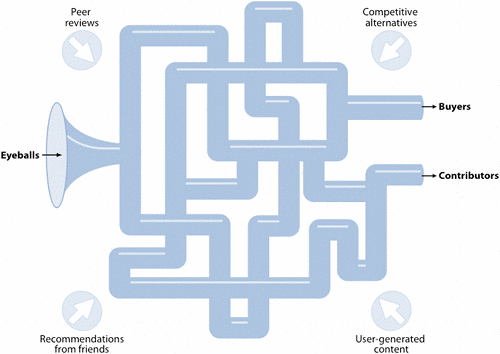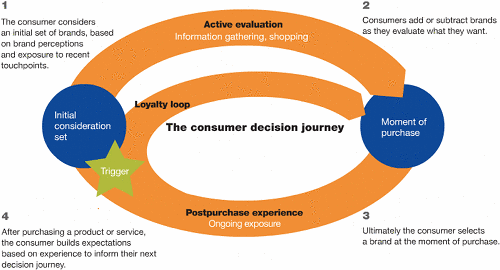The purchase funnel is no more
The purchase funnel has always been one of the main tenets of marketing theory.

We’ve intuitively known for while that it no longer holds true (if it ever did), but despite many attempts, we’ve had nothing come along that’s replaced it. For example, Forrester had a go a couple of years ago with the diagram below, but crucially it failed to provide a model that was easy to visualise, and it failed to catch on (surprisingly, neither did Giles Rhys Jones’ simpler alternative).
Now, finally, we have a viable alternative model, along with the science to back it up. McKinsey have conducted a study examining the purchase decisions of almost 20,000 consumers across five industries and three continents, and come up with what they call the consumer decision journey:
The funnel concept fails to capture all the touch points and key buying factors resulting from the explosion of product choices and digital channels, coupled with the emergence of an increasingly discerning, well-informed consumer. A more sophisticated approach is required to help marketers navigate this environment, which is less linear and more complicated than the funnel suggests. We call this approach the consumer decision journey.
Because of the shift away from one-way communication — from marketers to consumers — toward a two-way conversation, marketers need a more systematic way to satisfy customer demands and manage word-of-mouth.
We hate the word ‘consumer’ (we are all people as far as We Are Social is concerned), but that doesn’t make their model any less valid. David Court, Director of McKinsey’s global Marketing & Sales practice, has an excellent presentation that explains the research and what it means for marketers. The most salient parts being:
You have a trigger of some sort, where people start across the decision journey — they are now going to move towards purchase. The first stage is initial consideration. In many industries, people actually start in their initial consideration of a brand with a relatively narrow list, we believe because of the busy lives and bombardment of media — it’s just very difficult to get through all this clutter in this consumers initial consideration set. However, once the consumer decides they are going to buy a product, they move into a stage that we call active evaluation. It is here that the number of brands they are considering increases. Which is exactly the opposite of the premise of the funnel, going from broad to narrow. This is the stage when the consumer is intent on purchasing and they are actively researching the product.
What marketers should know
The most important thing for marketers to do is to make sure that their marketing activities are aligned against how their consumers research and buy products […] companies need to look at their messaging in light of where they have the greatest opportunity. For example, companies’ messaging is all about trying to get into the initial consideration set, and yet, when the consumer reaches out during their active evaluation stage, they’re not providing the right facts and testimonials that the consumer is looking for […] most companies are going to have to make fundamental investment in what we would call consumer driven marketingConsumer versus company driven touchpoints
We analytically looked at which touchpoints were most influencing the consumer’s decision. We found two types — company driven versus consumer driven. In consumer driven, the consumer is reaching out to get information — they’re talking to their friends, doing internet searches, seeing what’s said on third party sites.In the initial consideration it was still very much still company driven — the advertising was a very critical part of the touch points that influenced the consumer. However, when we got into active evaluation, two thirds of the influence of those most powerful touchpoints were from consumer driven touchpoints — word of mouth, talking to friends and family, searching on the internet.
And that is a very big change — you need to develop ways for people to talk about your product, so that word of mouth works. Be represented on independent internet sites where people will go and research and buy products. Because, if you don’t have enough presence on those types of consumer driven approaches, when the consumer is reaching out during active evaluation, you’re not there for them to find.
Amen to that…

